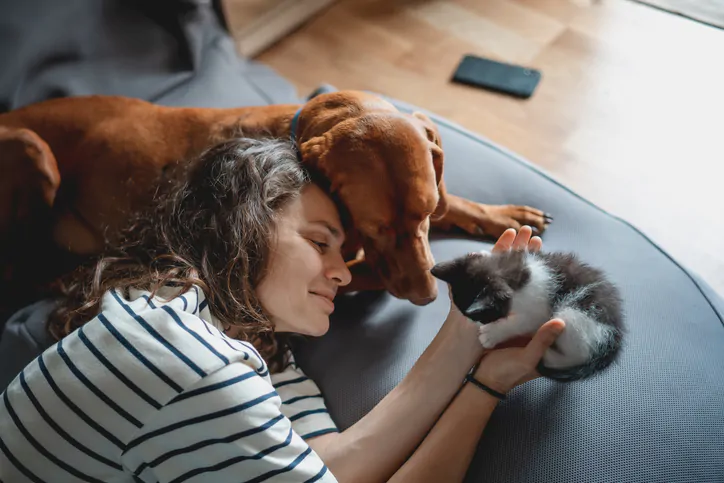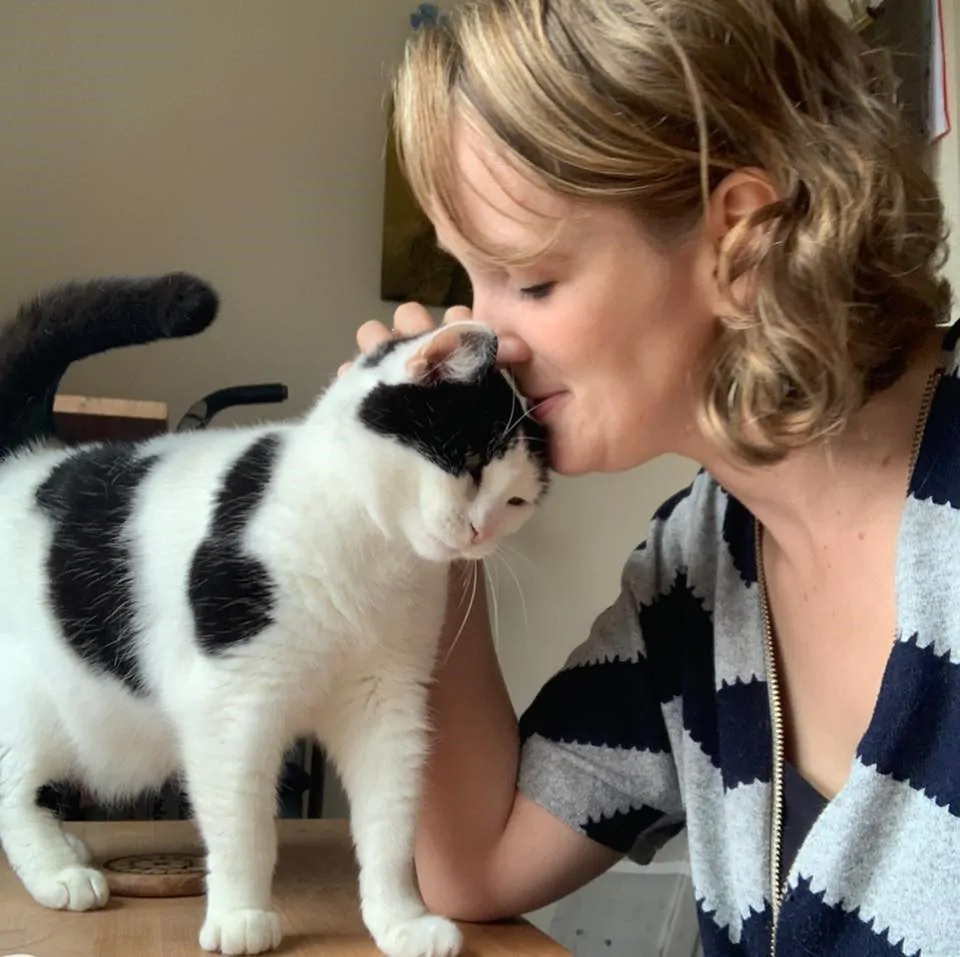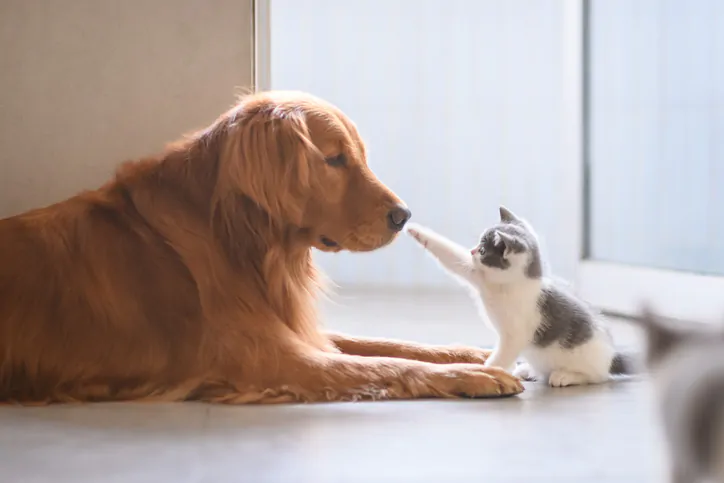
Introducing a kitten to a dog: How to do it well

Lucy Hoile
2 July 2025
Want to bring a new kitten into the family but worried about how your dog will feel?
The good news is that you can successfully expand your four-legged family if you plan things properly.
Below, expert feline behaviourist Lucy Hoile explains how to tell if your dog would be comfortable living with a cat. She shares her step-by-step guide to managing introductions so your kitten and dog can have the best relationship.
- How to tell if your dog likes cats
- Provide necessary resources
- Setting up your kitten and dog for long-term success
- More about kitten introductions to a dog
How to tell if your dog likes cats
Before deciding whether it’s a good idea to bring a kitten home, think about your dog’s behaviour.
- Are they a herding breed or a Terrier and will be motivated to chase a cat?
- Do they react negatively to cats while out on walks?
Your kitten is going to be very active and running around the house, making them a prime chase target for dogs with high prey drive.
Choosing a compatible kitten for your dog
Once you’re comfortable that your dog doesn’t have negative feelings towards cats, you can think about finding the right kitten for them.
When it comes to compatibility, you’re looking for a kitten who:
- Is well socialised
- Has already met a well-socialised and friendly dog
- Has a similar personality to your dog – if your dog is older or quiet, choose a more relaxed kitten
- Hasn’t had any bad experiences of being chased or harmed by a dog
Think about getting two kittens if you have an older dog so they can play with each other.

A step-by-step guide to introducing a kitten to a dog
Step one – Settle in your kitten
Your kitten needs to decompress and adjust to their new home before any introductions begin.
- Give your kitten their own room that’s inaccessible to the dog.
- Make sure the room has all the resources they need including a litter tray, bowls, a cat tree, and several beds.
- Spend time in the room and build your relationship with them so you can better manage their relationship with the dog.
Once your kitten is happy and settled after a few days, you can introduce scent.
Step two – Scent swap
- Gently rub your dog’s fur with a soft, clean microfibre cloth and put it in your kitten’s room.
- Take one of your kitten’s blankets/beds or rub a soft cloth along their fur and bring this to your dog.
Watch your kitten’s behaviour – hissing is a sign of worry and means intros need to go more slowly. If they show indifference or sit on/rub the cloth then that’s a more positive sign.
If both kitten and dog are comfortable with each other’s scent you can then have them meet.
Step three – Introductions with a barrier or lead
For face-to-face interactions, you want your kitten to be in control and feel they can come and go as they please.
- Put your dog on a lead or behind a baby gate which your kitten can’t get through.
- Open the door to your kitten’s room and let them explore in their own time. They should be able to go back into that room whenever they want.
- Focus on keeping your dog controlled while your kitten looks around. Keep treats and toys close to hand so you can get their attention if needed.
- Keep the intro short and sweet so you can keep control of your dog and things don’t get overwhelming for anyone.
- Practice doing several of these brief and relaxed hellos.
You need more managed interactions while your dog is barking, scrabbling, and desperate to see your kitten. Only once they’re calm and unbothered around your kitten can you move on to the next step.
Step four – Introductions without a barrier
Think about a time in the day when you can best supervise this next stage. Evenings often work well as everyone is together and calm.
- Go about your normal routine
- Keep your dog on a lead and let your kitten in the room
- Lengthen the time so they’re spending a few hours together
Once you’re comfortable doing this, you can let your dog off their lead. Make sure they stay settled and calm by:
- Distracting them with a chew, Kong, or a puzzle feeder toy
- Giving them a strategic walk before an introduction, making sure they have time to sniff
You need to be proactive in managing interactions:
- Keep your kitten stimulated and give them lots of playtime so they’re not directing all that energy on the dog.
- Give your kitten outdoor access if it’s safe to do so. This encourages their instinctive behaviour through hunting while your dog has cat-free time.
- Don’t let your kitten scratch the dog to ‘let them know who’s boss’. It’s a sign of fear and puts both animals at risk.
- Don’t just put your kitten or dog in a crate and let the other come over to suss them out as it will cause panic and stress.
Continue to supervise and as time goes on you can gradually step back from managing interactions. Base this on your kitten’s behaviour towards your dog.

Setting up your kitten and dog for long-term success
Your kitten should always feel safe around your dog. That means easy access to their resources and having their own routes and escape options in the house.
- Keep their food and water bowls, litter tray, and beds out of the dog’s reach and path.
- To separate resources, you can use internal cat flaps and baby gates wide enough for your cat to get through. You can also train your dog not to go into certain areas where you’ve placed your kitten’s things.
- Give them lots of high spaces such as tall cat trees, shelving, and the tops of furniture.
- Make sure they have bolt holes if they find themselves being chased.
Your dog needs to be heavily trained with recall, sit, and leave it so that you can diffuse and stop a chase from starting.
- Practice in quiet and busy environments
- Practice it around the kitten
Equally, for your dog’s well-being, your kitten needs to be kept stimulated:
- Give your kitten daily play sessions while they’re young and be strategic about the timing. A 20 minute play in the evening can help calm them down.
- Make sure they have lots of opportunities for independent play with toys in both the main bit of the home and dog-free areas.
- Moving toys and puzzle feeders (away from the dog) is a good way to stimulate your kitten if you aren’t there.
- Set up cat trees and tunnels so they can climb, run, jump, and play.
- Give your kitten lots of beds in which to sleep so they don’t steal the dog’s bed.
You’re looking to build resilience in your pets through plenty of positive interactions. So if there is one time where a chase happens, they’re both resilient enough to move past it.
More about kitten introductions to a dog
Kitten hissing at dog
If your kitten is hissing and spitting at the dog, you’ve likely moved through the intro process to quickly.
Give them both some space and breathing time then gradually work through introductions again. You need to go at the kitten’s pace as they feel insecure and worried.
Dog obsessed with the new kitten
If your dog is obsessed with the kitten, you need to allow them to be around each other without your dog having direct access.
A cat tree is helpful for this as it means your kitten can be close by without your dog being able to reach them. From there you can work with your dog to calm and relax them.


